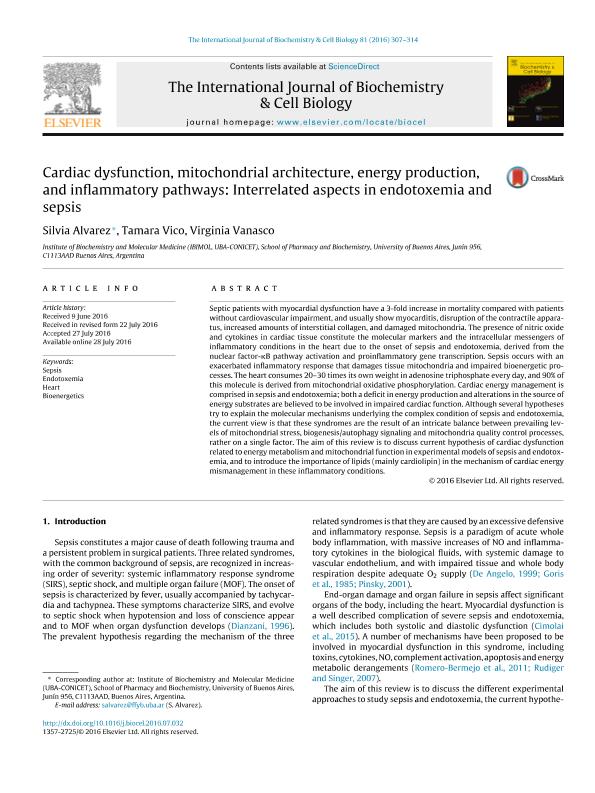Mostrar el registro sencillo del ítem
dc.contributor.author
Alvarez, Silvia

dc.contributor.author
Vico, Tamara Antonela

dc.contributor.author
Vanasco, Virginia

dc.date.available
2018-06-05T21:03:42Z
dc.date.issued
2016-12
dc.identifier.citation
Alvarez, Silvia; Vico, Tamara Antonela; Vanasco, Virginia; Cardiac dysfunction, mitochondrial architecture, energy production, and inflammatory pathways: Interrelated aspects in endotoxemia and sepsis; Pergamon-Elsevier Science Ltd; International Journal of Biochemistry and Cellular Biology; 81; Part B; 12-2016; 307-314
dc.identifier.issn
1357-2725
dc.identifier.uri
http://hdl.handle.net/11336/47412
dc.description.abstract
Septic patients with myocardial dysfunction have a 3-fold increase in mortality compared with patients without cardiovascular impairment, and usually show myocarditis, disruption of the contractile apparatus, increased amounts of interstitial collagen, and damaged mitochondria. The presence of nitric oxide and cytokines in cardiac tissue constitute the molecular markers and the intracellular messengers of inflammatory conditions in the heart due to the onset of sepsis and endotoxemia, derived from the nuclear factor-κB pathway activation and proinflammatory gene transcription. Sepsis occurs with an exacerbated inflammatory response that damages tissue mitochondria and impaired bioenergetic processes. The heart consumes 20–30 times its own weight in adenosine triphosphate every day, and 90% of this molecule is derived from mitochondrial oxidative phosphorylation. Cardiac energy management is comprised in sepsis and endotoxemia; both a deficit in energy production and alterations in the source of energy substrates are believed to be involved in impaired cardiac function. Although several hypotheses try to explain the molecular mechanisms underlying the complex condition of sepsis and endotoxemia, the current view is that these syndromes are the result of an intricate balance between prevailing levels of mitochondrial stress, biogenesis/autophagy signaling and mitochondria quality control processes, rather on a single factor. The aim of this review is to discuss current hypothesis of cardiac dysfunction related to energy metabolism and mitochondrial function in experimental models of sepsis and endotoxemia, and to introduce the importance of lipids (mainly cardiolipin) in the mechanism of cardiac energy mismanagement in these inflammatory conditions.
dc.format
application/pdf
dc.language.iso
eng
dc.publisher
Pergamon-Elsevier Science Ltd

dc.rights
info:eu-repo/semantics/openAccess
dc.rights.uri
https://creativecommons.org/licenses/by-nc-nd/2.5/ar/
dc.subject
Sepsis
dc.subject
Endotoxemia
dc.subject
Heart
dc.subject
Bioenergetics
dc.subject.classification
Otras Ciencias Biológicas

dc.subject.classification
Ciencias Biológicas

dc.subject.classification
CIENCIAS NATURALES Y EXACTAS

dc.title
Cardiac dysfunction, mitochondrial architecture, energy production, and inflammatory pathways: Interrelated aspects in endotoxemia and sepsis
dc.type
info:eu-repo/semantics/article
dc.type
info:ar-repo/semantics/artículo
dc.type
info:eu-repo/semantics/publishedVersion
dc.date.updated
2018-06-05T20:05:22Z
dc.journal.volume
81
dc.journal.number
Part B
dc.journal.pagination
307-314
dc.journal.pais
Estados Unidos

dc.description.fil
Fil: Alvarez, Silvia. Consejo Nacional de Investigaciones Científicas y Técnicas. Oficina de Coordinación Administrativa Houssay. Instituto de Bioquímica y Medicina Molecular. Universidad de Buenos Aires. Facultad Medicina. Instituto de Bioquímica y Medicina Molecular; Argentina
dc.description.fil
Fil: Vico, Tamara Antonela. Consejo Nacional de Investigaciones Científicas y Técnicas. Oficina de Coordinación Administrativa Houssay. Instituto de Bioquímica y Medicina Molecular. Universidad de Buenos Aires. Facultad Medicina. Instituto de Bioquímica y Medicina Molecular; Argentina
dc.description.fil
Fil: Vanasco, Virginia. Consejo Nacional de Investigaciones Científicas y Técnicas. Oficina de Coordinación Administrativa Houssay. Instituto de Bioquímica y Medicina Molecular. Universidad de Buenos Aires. Facultad Medicina. Instituto de Bioquímica y Medicina Molecular; Argentina
dc.journal.title
International Journal of Biochemistry and Cellular Biology

dc.relation.alternativeid
info:eu-repo/semantics/altIdentifier/doi/https://dx.doi.org/10.1016/j.biocel.2016.07.032
dc.relation.alternativeid
info:eu-repo/semantics/altIdentifier/url/https://www.sciencedirect.com/science/article/pii/S1357272516302060
Archivos asociados
